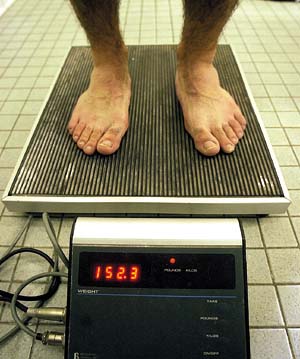
The CIF’s Weight Certification Program is an improvement and a
move in the right direction, but it still has critics
Ten years ago, the death of three wrestlers in a span of six weeks began a national debate over the weight-loss methods surrounding the sport.
Beginning in November of 1997, a freshman at Campbell University in North Carolina, a senior at the University of Wisconsin-La Crosse, and a junior at the University of Michigan were all involved in excessive weight-loss programs. All three died in an effort to shed extra pounds in order to reach a certain weight class.
The deaths sparked the NCAA into enforcing tougher regulations on weight-loss regimens, and the move has since stretched down toward the high school ranks. Two years ago, the California Interscholastic Federation began implementing its Wrestling Weight Certification Program.
Essentially, using a minimum standard of seven percent body fat on males and 12 percent body fat on females, the program sets a limit to how much weight each wrestler should lose in a given week, as well as a healthy minimum weight for each wrestler.
It’s a step in the right direction, but the program needs some tweaking, said Gilroy High assistant wrestling coach Mike Koester.
“What makes it better than the old system is that there wasn’t a system before,” Koester said. “It tells you what’s the lowest a kid can go in terms of his body fat. That’s what it did solve. But as far as the rapid weight loss thing, it really didn’t solve that.”
That sentiment was similar for Randy Logue, an SBHS teacher and wrestling coach of 20 years.
“All these things are positive,” Logue said. “But if were going to try and make wrestling healthy and safe for the kids, we have a few more steps to go.”
At the beginning of the season, some 83 wrestlers from San Benito began the CIF’s Weight Certification Program.
First, the grapplers needed to present a urine sample in order to determine proper hydration. The hydration level is measured by a piece of equipment called a refractometer.
Once the hydration level was deemed acceptable, each wrestler stepped onto a Tanita scale, which calculated body fat by sending an electrical signal through the lower extremities.
Coaches are not allowed to administer the tests or even be in the room while the test is being given, however. A Central Coast Section assessor must be present and conduct the test.
Following the test, a weight-loss chart is presented to each wrestler with a day-by-day breakdown of the amount of weight that particular wrestler may lose to reach a certain weight class, with a minimum weight the wrestler may achieve by the end of the season.
“The good thing about it is that if it’s done properly, it provides some safeguards for controlled weight loss,” said Matt Olejnik, varsity wrestling coach at San Benito High.
The program can be helpful by putting restrictions on a wrestler who may want to radically alter their weight, as well as provide a healthy weight-loss plan for a heavier wrestler to shed pounds.
But the determining factor surrounding the CIF’s Weight Cer-tification Program is body fat, and coaches from Gilroy and San Benito both feel the most accurate way of measuring body fat is an underwater test – where wrestlers are weighed in and out of water – and not necessarily on the Tanita scale.
“It’s funny, a kid will be over 200 pounds and [the Tanita scale] says he can get down to 130 pounds, but it will take three months,” Koester said. “By the time he makes his weight, the season will be over.”
“We have kids at 195 (pounds), and the chart says they can go down to 145,” Logue added. “They’re only gonna do that if they chop their legs off.
“We have a couple of heavyweight kids and it says they can go down to 160. Realistically, there’s no way that’s gonna happen. Mathematically, that’s what the formula says.”
Logue feels this leaves the door open on perhaps an unscrupulous coach, who will use the drastic weight differential listed on the charts as a reason to push a wrestler toward a lower weight.
As Olejnik points out, the weight-loss charts provide a day-by-day breakdown of what the minimum weight must be for each particular wrestler, but it does not force any wrestler to lose weight by this particular breakdown, which lends itself to crash dieting.
For instance, a 200-pound wrestler with 30 percent body fat on Dec. 8 may seek to lower his weight to 190 pounds. The chart says he may reach that weight, at the earliest, by Dec. 30. And while there is a minimum weight each day – from 199 pounds to 198 to 197, etc. – there is no regulation on the 200-pound wrestler from losing 10 pounds the day before, on Dec. 29.
“I don’t think it’s a fool-proof thing, and it’s not preventing kids from crashing,” Olejnik said. “I support the idea of maintaining a controlled environment and taking the weight off slowly, but it doesn’t necessarily provide that.”
Olejnik also noted the ways to manipulate the results. With your age, weight and height taken during the initial testing, the varsity coach pointed out it’s very easy to stand on your tippy-toes or bend your knees slightly in order to alter the results.
“Whenever competition is involved, someone is going to push the envelope,” Logue said. “That’s just human nature.”
Former Gilroy High wrestling coach Chuck Ogle said the program needs to be reworked considering that there is no oversight over the course of the season.
“I think it’s dumb, too many people cheat,” Ogle said. “What it’s supposed to do is protect the kids, but I think it puts a burden on them.
“I don’t know what the answer is, but I know this isn’t it.”
According to Duane Morgan, Central Coast Section Assistant Commissioner and wrestling rules interpreter for the state of California, the program is a work in progress, but should give wrestlers and their parents some piece of mind.
“For the most part, I think it’s become part of the culture of wrestling, and ultimately created a safer environment,” Morgan said. “I think it’s going to protect the kids’ health and give the parents comfort that there is something scientific tied to cutting weight.”
Koester said there is only one perfect answer.
“The solution is to have the kids wrestle what they weigh,” he said. “Get big and strong, and wrestle.”
—
Josh Koehn contributed to this story









